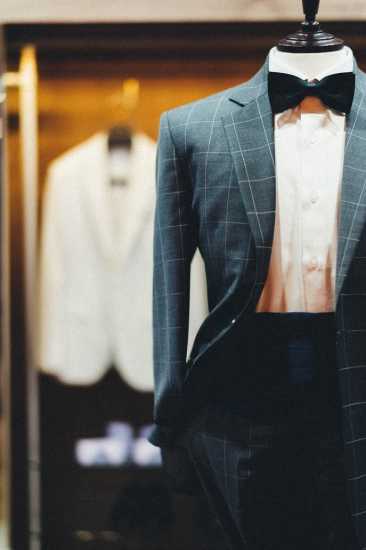How to Measure and Understand Men’s Suit Sizes Like a Pro
Are you wondering how suit sizes work? Wonder no more! Today we’ll be taking a look at suit sizes for men. We explored suit jacket sizes in our article on how to understand a suit size chart, and we’ve filled you in on dress shirt sizing too. We’ve also taken an in-depth look at how to get perfect suit measurements for each body part. But how do you assess if a suit fits right? How do men’s suit sizes fit the equation? The Oliver Wicks experts have everything you need to know.

- How Should a Suit Fit?
- Understanding Suit Sizes
- How to Measure Your Suit Size
- Tips for Measuring Your Suit Correctly
- Conclusion: Your Path to a Great Fit
How Should a Suit Fit?
A proper fit is paramount for a sharp and professional appearance. We explained everything you’ve ever wanted to know about fit in this article, however here is a detailed breakdown of how each component of a suit should fit your body:
The Suit Jacket
Shoulders
The jacket's shoulder seam should end precisely where your natural shoulder does. There should be no dimpling (indicating the jacket is too tight) or excess fabric hanging over your shoulder (too loose).
Collar
The jacket collar should lie flatly and comfortably against your shirt collar. There should be no pulling, puckering, or gaping as you move. A proper fit means the collar stays in place without using your tie or bowtie to force it into position.
Chest
When buttoned, the jacket should contour to your chest without pulling or creating an "X" shape around the button. You should be able to slide a hand comfortably between your chest and the jacket.
Button Stance
For a standard two-button suit, the top button should sit approximately 1-3 fingers' width above your navel.
Sleeve Length
The jacket sleeve should end just before your wrist bone, allowing for ¼ to ½ inch of your shirt cuff to be visible.
Jacket Length
The jacket should be long enough to fully cover the seat of your trousers. A good guideline is for the hem to end around the second knuckle of your thumb when your arms are relaxed at your sides.
The Trousers (Pants)
Waist
The trousers should fit comfortably around your waist without the need for a belt to hold them up. You should be able to sit and move without them feeling restrictive.
Hips
The fabric should drape smoothly over your hips and the seat. There should be no pulling at the pockets or tightness that causes horizontal lines.
The Break
This refers to the fold of fabric at the bottom of the trouser leg where it meets your shoe. While personal preference plays a role, a slight or half break is a classic choice. There should not be excessive bunching of fabric.
Understanding Suit Sizes
The numbers on a suit's label do not always directly correlate with your physical tape measurements. This is because a well-made suit includes a calculated amount of additional fabric called ‘ease’ for comfort and movement. Our job as tailors is to use systematic formulas to add this ease, ensuring a perfect cut.
How to Read a Suit Label
A standard suit size label typically has two parts: a number and a letter (e.g., 40R).
- The Number (e.g., 40): This corresponds to the jacket chest size. While in the US system this is designed to be close to your actual chest measurement in inches, this can vary significantly by brand and region.
- The Letter (e.g., R): This indicates the jacket's length: S for Short, R for Regular, and L for Long.
Standard Suit Sizing and Conversion Chart
The following is a standard conversion chart for men's suit sizes. Always consult a brand's specific chart when available, as sizing can vary, especially between US and European brands.
| International | US | Euro | Chest (") | Waist (") | Arm (") |
|---|---|---|---|---|---|
| S | 34 | 46 | 34 | 28 | 31.5 |
| S | 36 | 46 | 36 | 30 | 32 |
| M | 38 | 48 | 38 | 32 | 32.5 |
| M | 40 | 48 | 40 | 34 | 33 |
| L | 42 | 50 | 42 | 36 | 33.5 |
| L | 44 | 52 | 44 | 38 | 34 |
| XL | 46 | 54 | 46 | 40 | 34.5 |
| XL | 48 | 55 | 48 | 42 | 35 |
| XXL | 50 | 56 | 50 | 44 | 35.5 |
| XXL | 52 | 56 | 52 | 46 | 36 |
It's important to remember that the sizes in the chart are based on statistical averages. Since every man's body is unique, finding a great off-the-rack suit involves knowing what to prioritize.
How to Choose the Best Off-the-Rack Fit
To find the best possible fit when buying a ready-to-wear suit, follow these key principles:
- Prioritize the areas that cannot be easily altered. A tailor has limits. Focus on getting a perfect fit in the shoulders, collar, and the overall length of the jacket first, as these are the most difficult and expensive parts to adjust.
- The shoulders are the most important factor. Above all else, ensure the jacket's shoulder seams sit perfectly on your natural shoulders. This is the foundation of a good fit.
- When in doubt, size up. It is always easier for a tailor to remove excess fabric than it is to let a garment out. If you are between sizes, choosing the larger size gives your tailor more material to work with.
- Remember pant style affects fit. When choosing trousers, keep in mind that pleated pants are designed to be roomier in the hips and thighs than modern flat-front pants.
The Inevitable Compromise
As you can see, finding a great off-the-rack suit often involves prioritizing one area of fit over another, followed by costly and time-consuming alterations. This is because ready-to-wear garments are built for an "average" body that doesn't really exist. For a fit that is perfect in every dimension without any compromises, a made-to-measure suit is the only true solution.
Understanding the Suit "Drop"
In the world of ready-to-wear suits, the term "drop" is a key concept that highlights the standardized sizing system. It has two distinct meanings you should know.
1. The Pant and Jacket Size Drop
This is the most common meaning of the term. The "drop" is the fixed difference in size between a suit jacket and the trousers it is sold with. The industry standard is a 6-inch drop. This means a size 40 jacket will automatically come with size 34 trousers (40 - 6 = 34).
2. The Jacket Taper Drop
Less commonly, "drop" can also describe the tapering of the jacket itself—the difference between the jacket's chest measurement and its waist measurement. A jacket with a low drop has a boxier, more traditional fit. A jacket with a high or "aggressive" drop is cut much closer to the body for a slim, modern silhouette.
Why the Drop Matters for Your Fit
The standard 6-inch drop is designed for a statistically "average" man. If your chest and waist measurements don't fit that specific ratio (for example, if you are athletic with a large chest and a slim waist), you will inevitably have to compromise on fit with an off-the-rack suit. This is one of the primary problems that a made-to-measure suit solves, as it allows for any combination of jacket and trouser size, built precisely for your body.
Suit Jacket Lengths
Suit jackets typically come in three standard lengths, indicated by a letter on the size tag (e.g., 40R).
- S (Short): Designed for men with a shorter torso and arms.
- R (Regular): The most common length, designed for men of average height.
- L (Long): Designed for men with a longer torso and arms.
Note: Some brands may also offer Extra Short (XS) and Extra Long (XL).
A Critical Note on Alterations
The overall length of a suit jacket is one of the most difficult and expensive parts to alter. High-quality jackets with functional sleeve cuffs (also known as "surgeon's cuffs") often cannot be altered in length without compromising the design. Therefore, prioritizing the correct length when you buy is essential.

How to Measure Yourself for a Suit
Taking accurate measurements is the most critical step to achieving a perfect fit. The following guide provides the basic steps for measuring the key areas of a suit jacket and trousers.
A Note on Our Measurement Videos
For a more practical guide, we highly recommend using our instructional videos. They walk you through every step of the process in an easy-to-follow visual format that can have you fully measured in 15 minutes or less. Create a free account on our site to access the complete video series.
Jacket Measurements
The jacket fit is the foundation of your entire look. For the best results, have a friend assist you with these measurements.
1. Chest
Stand in a relaxed, natural posture without puffing out your chest. Wrap a measuring tape around the fullest part of your chest, ensuring it passes under your arms and is level across your back. The tape should be snug, but not tight—you should be able to fit one finger between it and your body.
2. Shoulders
Wear a shirt that fits you well. Measure straight across your back from the point of one shoulder seam to the other. This measurement is crucial for ensuring the jacket sits correctly on your frame.
3. Sleeve Length
Stand with your arms relaxed at your sides. Start the tape measure at the shoulder seam of your shirt and measure down your arm to the second knuckle of your thumb. A correct sleeve length ensures about ¼ to ½ inch of your shirt cuff is visible.
What Jacket Length Am I?
While height is the primary factor, your chest measurement can also help you determine your ideal jacket length. Use these measurements as a starting guide:
- Short (S): Recommended for heights at or under 5’ 7”, with a chest measurement typically between 36-46 inches.
- Regular (R): Recommended for heights between 5' 7” and 5’ 11”, with a chest measurement typically between 36-54 inches.
- Long (L): Recommended for heights 6' 0" and taller.
When Standard Sizes Don't Work
These guidelines are based on standard proportions. If you have an unusual build (e.g., a long torso and shorter arms), you may find that off-the-rack suits always involve a compromise on fit. This is the exact challenge that made-to-measure tailoring was designed to solve, allowing for a perfect fit regardless of your proportions.
Pant Measurements
For trousers, achieving the correct waist and hip fit is the top priority, as the length is more easily altered.
1. Waist
Measure at your belly button for higher rise trousers, and two to three fingers below it for low-rise. Allow for a generous, but not baggy, fit from the tape measure. Don’t let the waist measurement drop assuming your slacks will too! It’s better to use a solution like suspenders to help you offset your physique and keep your pants at your waist rather than wearing your trousers in the wrong place. If you don’t plan to wear a belt, or are fitting for a tuxedo, be very precise, as this measurement is needed for the right fit.
2. Hips
Wrap the measuring tape around the widest part of your buttocks, ensuring the tape remains level all the way around. Place two fingers under the tape to ensure there is enough ease for comfortable movement and to prevent issues like pocket flare or strain on the seams.
3. Outseam
Stand up straight. Measure from the very top of your waistband down the outside of your leg to the point where you want your trousers to end. When in doubt, it is always better to measure a little longer; trousers can easily be shortened but not lengthened.
4. Inseam
Take a pair of trousers that you feel has the perfect length. Lay them flat and measure from the highest point of the crotch seam straight down the inside of the leg to the hem. This measurement is crucial for our tailors to determine the ideal rise of your custom trousers.
Vest Measurements and Styling
For a three-piece suit, the vest (or waistcoat) is designed to work with the other pieces. If you are measuring for a vest separately, here’s how to do it.
How to Measure for a Vest
Before you begin, put on the dress shirt and trousers you intend to wear with the vest. This ensures the most accurate measurements.
- Waist: Measure around your waist at the point just above your suit trousers.
- Chest: Repeat the same chest (underarm) measurement that you took for your jacket.
How to Wear a Vest
Traditionally, a vest is almost always worn with a jacket. Wearing it alone as an outer layer is a more casual, modern style choice. Ultimately, fashion is about personal expression, so you can decide when to follow tradition and when to break the rules.
Tips for Measuring Your Suit Correctly
To get the most accurate results from your measurements, keep these professional tips in mind.
- When possible, try it on. Sizes can vary dramatically between different brands, styles, and even fabrics. If you have the option with a ready-to-wear suit, trying it on is the most reliable way to assess the fit, especially in the critical shoulder area.
- Prepare for a fitting. If you are being fitted in-store or for a made-to-measure suit, wear a well-fitting dress shirt and proper dress shoes. This helps the fitter see how the suit will drape and interact with the other elements of your outfit.
- Be honest with the tape measure. It can be tempting to suck in your stomach or puff out your chest to get a "better" number, but this only compromises the final fit. Allow the tape to measure your natural posture. A good tailor uses these honest measurements to create a suit that will flatter you.
- Don't get attached to a specific size. A "size 40" can vary dramatically between brands and even between different styles from the same brand. Your preferred style or fit will significantly affect how a suit feels. For example, double-breasted suits are cut closer and feel tighter than a standard two-piece, while blazers are often designed for a looser fit. Always let the look and feel of the suit on your body be the guide, not the number on the label.
- Don't rely on your chest measurement alone. Even in sizing systems where the jacket size is meant to match your chest measurement (e.g., a 38" chest for a size 38 suit), this is only a starting point. Always consult the brand's specific size chart to translate your body measurements into their sizing system.
- Stand naturally. When measuring, stand in a relaxed, neutral posture—how you would stand when waiting for a bus. Don&#t stand stiffly like you're on parade, clench your muscles, or slouch. Any unnatural posture will distort your measurements.

Conclusion: Your Path to a Great Fit
Understanding men's suit sizes is the key to presenting a sharp, sophisticated image. While off-the-rack suits offer convenience, they are built for an "average" body that few men actually have, often leading to compromises in fit.
Final Recommendations
- For the best possible result, choose made-to-measure. It is the superior choice for building a versatile business casual wardrobe or for any important occasion, as it guarantees a great fit without compromise.
- When buying off-the-rack, prioritize what can't be changed. If you need a suit quickly for an unexpected event like a funeral, focus on getting a perfect fit in the shoulders and the jacket length. A tailor can adjust the waist, but they cannot easily fix these foundational areas.
- Know your measurements. Taking the time to accurately measure yourself is a skill that empowers you to be a smarter shopper and communicate your needs effectively to any tailor or retailer.
A great fitting suit is one of the best investments a man can make. A great fit is always worth it, and we are confident that with this guide, you are now equipped to find yours.
Oliver Wicks
The Fit That Suits You
